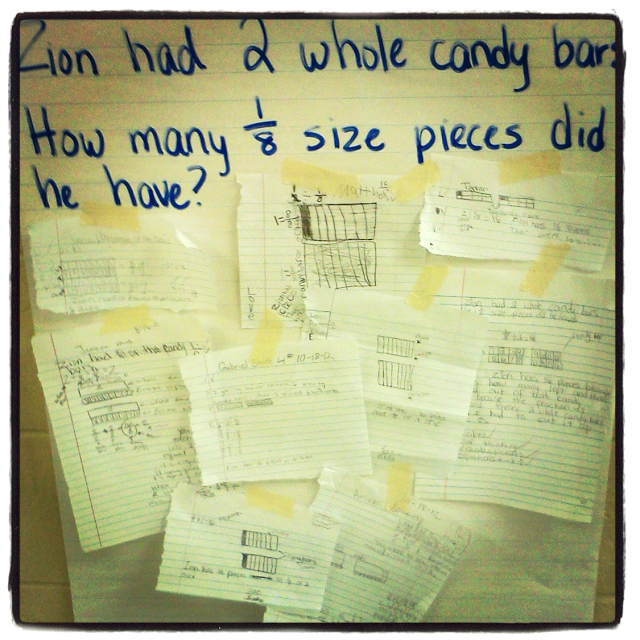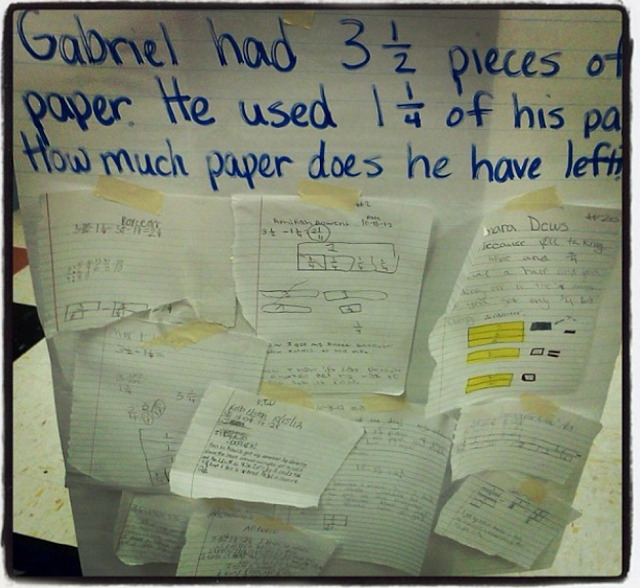Once a week, I do a cognitively demanding math task lesson to expose my students to rigorous word problems and allow them to learn from each other. I do this with the skill we are working on (if most of the students have mastered it) a review skill, or even to introduce a new skill. 90% of the problems are word problems so the students have a context to deal with and not just a “naked” equation. Here is an example of a math task that I used to introduce the skill of dividing unit fractions by whole numbers:
As a class, we read the task. Depending on the task, I will ask questions to ensure they understand the task. However, sometimes I just tell the students to begin solving the problem. The students know they have spend a few moments privately thinking about the task at hand before they can even begin solving it. Then, they start the task. They know when they are finished they have to make sure they showed the LOVE. Read more about this LOVE acronym and grab some freebies by clicking here. Here is a quick breakdown of LOVE.
L: Labels. They label the numbers and any visuals/models.
O: Our Thinking. They have to connect the answer back to the problem by writing a complete sentence answer the question. For example: Instead of just writing 6 R 1, they have to write, Bob will have 6 cookies in each bag, with 1 cookie left over.
V: Visuals: Models and visuals to show their work or prove their answers.
E: Equation. They have to label each number in the equation by referring back to the word problem.
As the students are completing the task, I am walking around, looking at their work, asking facilitating questions of some students, and choosing a sequence of student work that I want to share. By this time if I have not stopped the students, the majority have begun or are finishing up the process of explaining how they got their answer and justifying why they know it is correct. Read more about how I teach my students to justify their answers by clicking HERE.
When I call the students back together, I ask several students to come up one at a time and show all of their work or part of their work on the ELMO based on my chosen sequence. The other students have to try to make sense of the student’s work. I ask questions of the other students to try to get them to pay attention and make sense of other people’s strategies. We discuss misconceptions, strategies, and new thinking while we analyze student work. When we are finished analyzing, I will have the students who were correct or parts were correct, tear their work out to go on the chart.
We then move into our lesson. Depending on the results of the task, I use the rest of my math time to do one or more of the following:
- Have the students complete a similar problem using a newly learned strategy from another student
- Whole group instruction (often based on concerns I noted from the math task)
- Have the entire class move to independent practice of the skill from the task
- Have the higher students complete math centers while I do some intensive remediation and bridging of gaps for the rest of students
- Move on to a new skill lesson
I have 90 minutes for math instruction each day. Overall, this math task lesson takes 30 minutes, depending on the task.
Here are some more examples of tasks completed by my students.











I love this! I've been wanting to add more student centered activities during my math block. I love how this involves the students from the start of the lesson and gets them thinking about applying the math concept to a "real life" situation. Thanks so much for sharing!
Lattes and Laughter
How long is your math class? Are you writing your own problems or do you have a resource you can share? I am looking to add more rigor to my class and transition into the common core method of teaching.
I'm starting this TOMORROW!! It will be our 1st day of small group instruction. YIKES. 6th grade. I'm diving in.
I've written a blog post about it and linked to your blog. Would you mind if I shared some LOVE cards I made???
Thanks!
Shannon
http://www.irunreadteach.wordpress.com